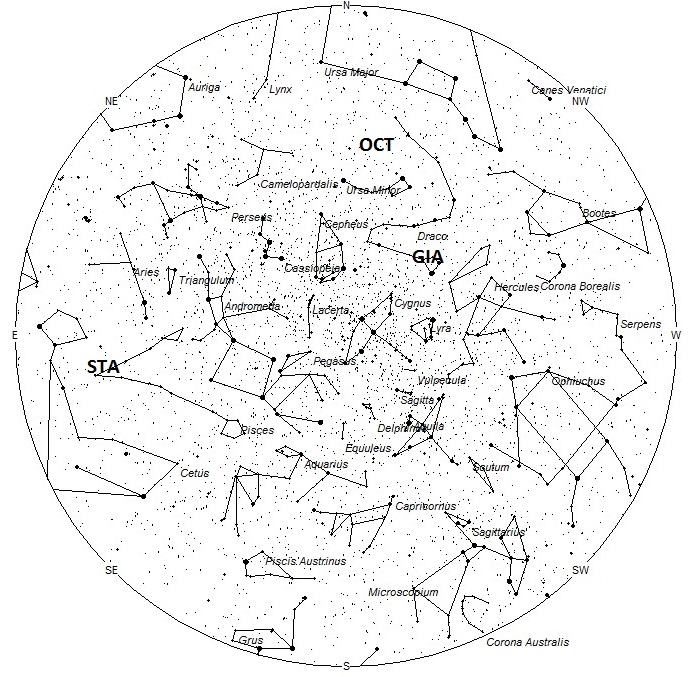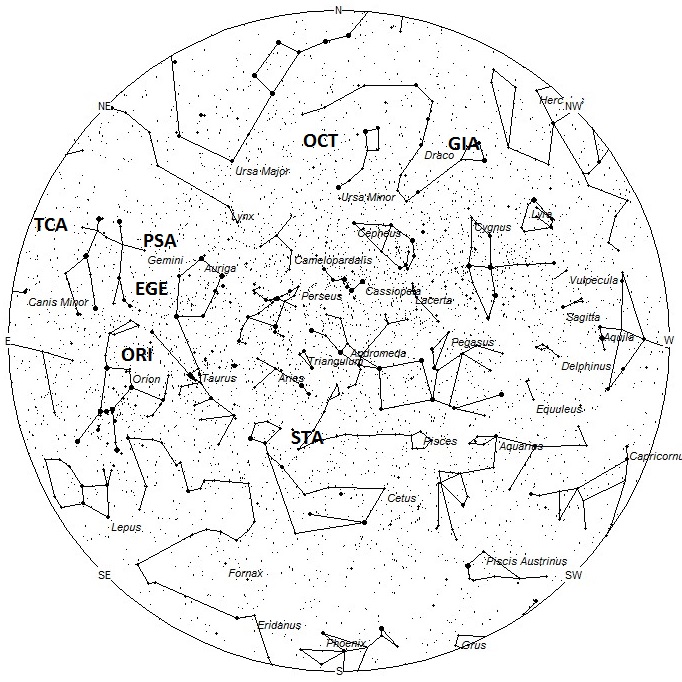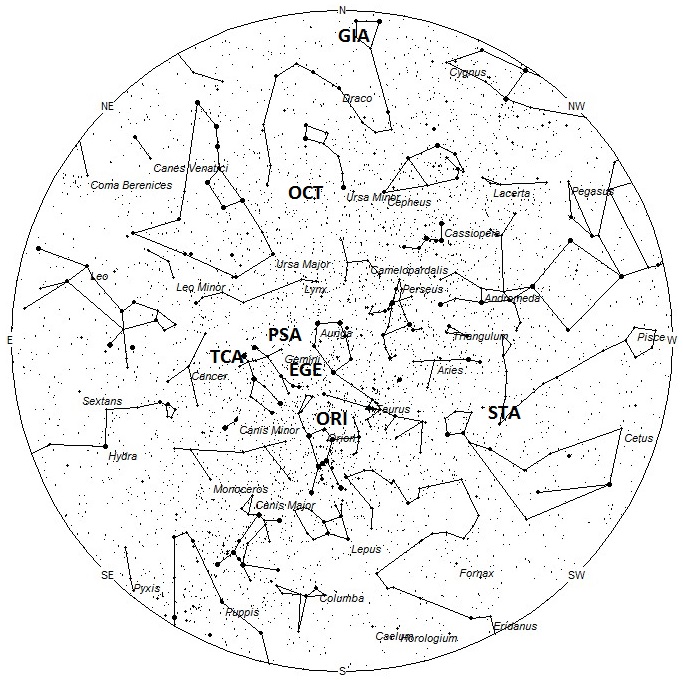During this period the moon reaches its new phase on Saturday October 5th. At this time the moon lies close to the sun and is not visible in the night sky. Next week the waxing crescent moon will enter the evening sky but will set long before the more active morning hours arrive. The estimated total hourly meteor rates for evening observers this week is near 4 for observers located in the northern hemisphere and 3 for those viewing south of the equator. For morning observers the estimated total hourly rates should be near 16 as seen from mid-northern latitudes and near 10 for observers viewing from tropical southern latitudes. The actual rates will also depend on factors such as personal light and motion perception, local weather conditions, alertness and experience in watching meteor activity. Note that the hourly rates listed below are estimates as viewed from dark sky sites away from urban light sources. Observers viewing from urban areas will see less activity as only the brightest meteors will be visible from such locations.
The radiant (the area of the sky where meteors appear to shoot from) positions and rates listed below are exact for Saturday night/Sunday morning October 5/6. These positions do not change greatly day to day so the listed coordinates may be used during this entire period. Most star atlases (available at science stores and planetariums) will provide maps with grid lines of the celestial coordinates so that you may find out exactly where these positions are located in the sky. A planisphere or computer planetarium program is also useful in showing the sky at any time of night on any date of the year. Activity from each radiant is best seen when it is positioned highest in the sky, either due north or south along the meridian, depending on your latitude. It must be remembered that meteor activity is rarely seen at the radiant position. Rather they shoot outwards from the radiant so it is best to center your field of view so that the radiant lies at the edge and not the center. Viewing there will allow you to easily trace the path of each meteor back to the radiant (if it is a shower member) or in another direction if it is a sporadic. Meteor activity is not seen from radiants that are located below the horizon. The positions below are listed in a west to east manner in order of right ascension (celestial longitude). The positions listed first are located further west therefore are accessible earlier in the night while those listed further down the list rise later in the night.
The following sources of meteoric activity are expected to be active this week:
The Draconids (GIA) are expected to be active on five evenings from October 6-10. Maximum activity this year is expected to occur anywhere from 17:00 UT October 8 to 0200 UT October 9. Observers should be on alert of any activity on the evening of October 8 local daylight time. No enhanced activity is expected but observations are encouraged. At maximum the radiant lies at 17:28 (262) +56. This position lies in southeastern Draco, very close to the position occupied by the faint star known as Kuma (Nu Draconis). This activity is best seen just as soon as it becomes totally dark. The expected hourly rates are a guess ranging from 0-5, most likely 0-1. With an entry velocity of 19 km/sec., the average Draconid meteor would be of very slow velocity. These meteors are poorly seen from the southern hemisphere due to the low radiant altitude seen from below the equator.
The Southern Taurids (STA) are currently active from a radiant located at 01:56 (029) +08. This position lies in southeastern Pisces, 13 degrees south of the 3rd magnitude star known as Sharatan (Beta Arietis) . These meteors may be seen all night long but the radiant is best placed near 0200 local daylight time (LDT) when it lies on the meridian and is located highest in the sky. Rates at this time should be near two per hour regardless of your location. With an entry velocity of 29 km/sec., the average Southern Taurid meteor would be of slow velocity.
The Orionids (ORI) are active from a radiant at 05:40 (085) +14, which places it in northwestern Orion, 4 degrees north of the 4th magnitude star known as Meissa (Lambda Orionis). This area of the sky is best placed in the sky during the last hour before dawn, when it lies highest above the horizon in a dark sky. Rates this week should be near 2 per hour no matter your location. With an entry velocity of 67 km/sec., most activity from this radiant would be of swift speed.
Recent analysis of the IMO video database has shown that the Epsilon Geminids (EGE) are active as early as September 22. The current radiant position would be located near 06:04 (091) +30, which places it in southern Auriga, just 2 degrees west of the 4th magnitude star known as Kappa Aurigae. This area of the sky is best placed in the sky during the last hour before dawn, when it lies highest above the horizon in a dark sky. Current rates should be near 1 per hour as seen from the northern hemisphere and less than 1 when view south of the equator. With an entry velocity of 70 km/sec., most activity from this radiant would be of swift speed.
The Psi Aurigids (PSA) were discovered among the radiants found by the IMO network of video cameras. This weak shower is active from October 8-18, which maximum activity occurring on the 15th. On the 8th, the radiant is located at 06:52 (103) +41. This position lies in a remote area of eastern Auriga, halfway between Castor (Alpha Geminorum) and Menkalinan (Beta Aurigae). This area of the sky is best placed in the sky during the last hour before dawn, when it lies highest above the horizon in a dark sky. Current rates should be less than 1 per hour no matter your location. With an entry velocity of 68 km/sec., most activity from this radiant would be of swift speed.
The Tau Cancrids (TCA) are active from October 9-25, with maximum activity occurring near the 17th. This shower was discovered by Peter Jenniskens and verified by IMO video data. Activity will be extremely weak this week from a radiant located at 08:24 (126) +29. This position lies in northwestern Cancer, 7 degrees east of the 1st magnitude star known as Pollux (Beta Geminorum). This area of the sky is best placed in the sky during the last hour before dawn, when it lies highest above the horizon in a dark sky. Current rates should be less than 1 per hour no matter your location. With an entry velocity of 69 km/sec., most activity from this radiant would be of swift speed.
The October Camelopardalids (OCT) were first noticed by Peter Jenniskens and mentioned in his book Meteor Showers and their Parent Comets. IMO video data has confirmed this activity which is short-lived and best seen on the mornings of October 5 and 6. The radiant lies at 11:12 (168) +79, which places it in a very remote portion of eastern Camelopardalis. The easiest way to pinpoint this radiant is to draw a line through the bottom of the “Little Dipper” (Gamma and Beta Ursae Minoris) westward. Draw another line from the “pointers” in teh “Big Dipper” (Alpha and Beta Ursae Majoris) and extend it northward Polaris. Where these 2 lines intersect will be close to the OCT radiant. This area of the sky is above the horizon most of the night for most observers in the northern hemisphere but is best placed in the sky during the last hour before dawn, when it lies highest above the horizon. Rates at maximum would be near 1 per hour as seen from the northern hemisphere. These meteors are basically invisible from locations south of the equator. With an entry velocity of 44 km/sec., most activity from this radiant would be of medium velocity.
As seen from the mid-northern hemisphere (45N) one would expect to see approximately 10 sporadic meteors per hour during the last hour before dawn as seen from rural observing sites. Evening rates would be near three per hour. As seen from the tropical southern latitudes (25S), morning rates would be near 5 per hour as seen from rural observing sites and two per hour during the evening hours. Locations between these two extremes would see activity between the listed figures.
The table below presents a list of radiants that are expected to be active this week. Rates and positions are exact for Saturday night/Sunday morning except where noted in the shower descriptions.
| SHOWER | DATE OF MAXIMUM ACTIVITY | CELESTIAL POSITION | ENTRY VELOCITY | CULMINATION | HOURLY RATE | CLASS |
| RA (RA in Deg.) DEC | Km/Sec | Local Daylight Time | North-South | |||
| Draconids (GIA) | Oct 08 | 17:28 (262) +56 | 19 | 17:00 | <1 – <1 | III |
| Southern Taurids (STA) | Oct 10 | 01:56 (029) +08 | 29 | 02:00 | 2 – 2 | II |
| Orionids (ORI) | Oct 22 | 05:40 (085) +14 | 67 | 06:00 | 2 – 2 | I |
| Epsilon Geminids (EGE) | Oct 22 | 06:04 (091) +30 | 70 | 06:00 | 1 – <1 | II |
| Psi Aurigids (PSA) | Oct 15 | 06:52 (103) +41 | 68 | 07:00 | <1 – <1 | IV |
| Tau Cancrids (TCA) | Oct 15 | 08:24 (126) +29 | 69 | 08:00 | <1 – <1 | IV |
| Oct Camelopardalids (OCT) | Oct 05 | 11:12 (168) +79 | 44 | 11:00 | 1 – <1 | IV |
 American Meteor Society
American Meteor Society


